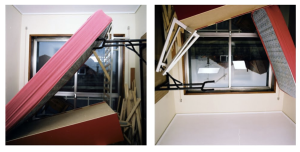
One of the recurrent ideas during our stay at this research centre is the essential importance of visualization to the research being carried on in the field of neuroscience. The labs are inhabited by time/space travelling devices which make possible for our eyes to watch the distant and commonly inaccessible world we have inside of us. Those technological accessories turn researchers into human beings with special powers and, combined with curiosity, open the possibility for a closer and deeper understanding of life.
Along with this extreme importance of technology for the research in this area, science has been giving more and more importance to the communication of its work to the general public (our presence here, at this lab, is definitely related to that need). This is a different need for visualization, it’s about creating to others visualizations of what science does – or, more precisely maybe, of what science sees.
There is a difference between what science sees and what science shows us. When science “communicates” with us it tells us about final conclusions and, sometimes, fabulous possibilities. But the intermediate steps of its work along with the unsuccessful routes taken hardly ever reach the common of us. And, nevertheless, those routes and steps are essential to reach knowledge and turn science’s conclusions more solid for they are informed by the route taken to achieve that knowledge and also by all the discarded paths along the way.
If someone drops me in a specific place, let’s say a café, in an unknown city, it will be very hard for me to get there again having not travelled the path. My point here is that with science knowledge the same might happen with common people (not sciencifically informed). When we are presented with the facts but have no clue how they were obtained it gets harder for us to get to that knowledge again later in the day. We have to travel the path.
And my extra point is: science’s machinery presents us magnificent new ways of “seeing” reality, and those images of reality are part of the path science travels to achieve knowledge. Why not letting us see a bit further? I think we might understand better the final conclusions and fantastic discoveries you get in the end. Are those images not reality? Are they constructed images created to help visualization? Sure! That’s why they can help us visualize too.
Well, this being said, all I really wanted to say is that I bumped, the other day, into The International Science & Engineering Visualization Challenge 2009, and found it interesting. It made think about everything I just wrote about, and also about a delicate frontier between science’s utilitary view of communicating through art and art itself with its uncompromised nature. But I’ll have to think and write about this later.
Meanwhile, take a peek into the link of that contest, promoted by Science Magazine and The National (US) Science Foundation. I´m sure you’ll find it interesting. I signal works nr. 2, a fantastic art piece, nr. 10 “Inside the brain: unraveling the mystery of Alzheimer’s Disease”, and nr. 13, a great photography.
See you soon.







































































